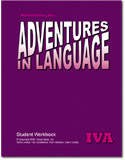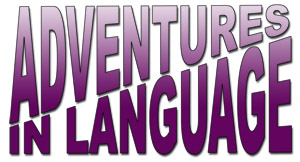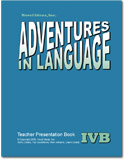


 |
|
Adventures
in Language IV ® (A and B) The fourth level of Adventures in Language ® is a specially designed highly motivating direct instruction grammar, usage, and written expression program for students in grades four to eight. This level of Adventures in Language may also be appropriate for older special education students to help them acquire more advanced language and written expression skills. The fourth level of Adventures in Language ® is divided into two parts: Part A (37 lessons) and Part B (48 lessons). Confidence and fluency develop through direct instruction lessons. Several different games are included in Part A: Mind Bogglers, Who’s the Audience, Why was it Written?, Grammar Island, Climb the Ladder—A Classification Game, the Analogies Game—Make the Connection, and Synonym Bingo. These games motivate the students to develop and practice the use of correct grammar and vocabulary in a fun-filled format. They also provide practice for common test-taking skills. Many of the games and activities at this level develop higher level thinking skills, also important in test taking. The students acquire important basic skills that enable them to be effective processors of information, speakers, and writers. Skills are coordinated to state standards and standardized tests for language and written expression. The Writing for Fluency track enables students to develop the skills required to do demand writing in a test-taking situation as well as within a classroom setting. Structured writing activities provide students with writing experiences that extend into other content areas such as science and social studies. Many of the topics found in the sentences, paragraphs, and passages in Level 4 of Adventures in Language ® are directly correlated to the topics covered in the Core Knowledge Curriculum for Grade 4 by Hirsch (1992). The authors feel that students can gain further reinforcement of the knowledge taught in various curriculum areas (e.g., science and social studies) through meeting them within the context of language instruction. Topics are also correlated to a number of the science and social studies curricula from various states. Find Out More!
|
home | webinars | newsletters | real readers | for the love of writing | reader's club | writing for success | adventures in language | readers & writers | series launchers | reading for success | tools for success | curriculum maps | student performance documentation forms | placement tests | additional rubrics for sra high performance writing | research-based data | order forms for all products | shop online | return policy | about us | training, coaching and consulting services | contact us